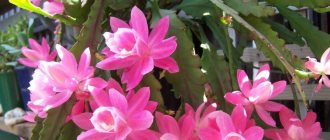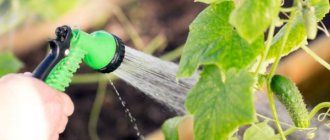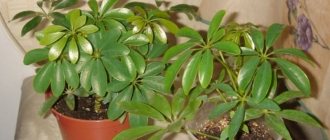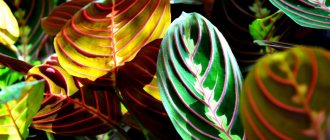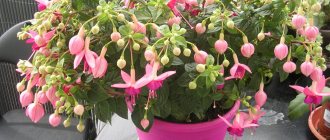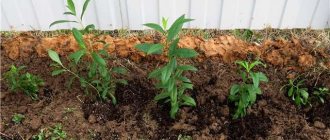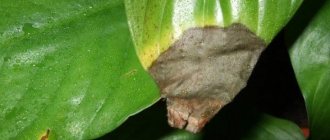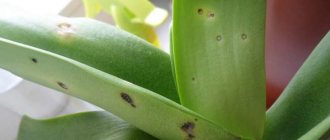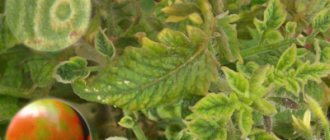Gloxinia (sinningia) sinningia
- Sinningia is beautiful
- Sinningia hybrid
- care features
- possible problems
- diseases and pests
The genus of perennial herbs and subshrubs includes 6 species, distributed in America (from Mexico to Brazil). The ones commonly grown are commonly known as Gloxinias. They originated from S. speciosa.
Sinningia speciosa
Large oval or oblong leaves, extending directly from the tuber, reach 20–25 cm in length and are pubescent. Sometimes reddish below. Large, showy bell-shaped flowers, about 5 cm long, in pink, red, blue, purple or white tones, sometimes with a contrasting rim, with expressive specks or spots of a different color.
Sinningia hybrida
The stem is shortened, pubescent, the leaves are arranged in the form of a basal rosette at its base, the leaf blades are oval, velvety-pubescent, dark gray-green in color. Flowers are up to 10-12 cm in diameter, on peduncles, axillary, bell-shaped or almost funnel-shaped, of various colors. It blooms in March-May; flowering times may vary depending on the conditions.
Gloxinias are plants that have a dormant period. This makes it difficult to grow them indoors.
After summer flowering and the gradual death of above-ground organs, the tubers are kept in a dry and cool place for 3–4 months.
In the spring, they are transplanted into a new substrate so that only the uppermost part remains above the ground. Plants are used in interior decoration solely for the sake of abundant seasonal flowering.
Features of care
Temperature: quite thermophilic, but does not withstand summer heat (especially dry ones).
Lighting: closer to light-loving, but requires a special light regime only during the forcing period (lighting up to 12-14 hours a day).
Humidity: It is advisable to water frequently, but not with too large portions of water. After flowering, until the start of the dormant period, watering is gradually reduced; tubers in pots are watered in winter only to prevent them from drying out.
Requires high atmospheric humidity (80-90%), but does not tolerate direct spraying; the air must be humidified at some distance from the plant.
Soil: a light mixture of leaf soil, peat and sand (3:1.5:1) with the addition of charcoal and mullein.
Nutrition: fertilizing is necessary only during the active growing season (especially during budding), mainly with organic fertilizers.
Reproduction: by sowing seeds (preferably in summer), leaf cuttings, dividing the tuber and root shoots.
Other care: the rest period is pronounced.
After flowering, the above-ground part begins to wither, which should be removed, then the pot should be moved to a cool (10-12 ° C) dark place or the tubers should be moved to sand or dry peat and stored at the same temperature.
They can be stored in sand until the end of February, after which in the spring they must be planted in the ground again, lightly pressing them into the loose soil mixture, and placed in a lighted place with a temperature of about 16°C.
- after spraying, spots similar to burns may appear on gloxinia leaves.
- It is not advisable to turn gloxinia towards the light - it may get sick.
- Excess sunlight can cause burns, falling of flowers and leaves of the plant
- for watering, use warm water - when watering with cold water, brown spots may appear on the leaves of Sinningia
Aphids of gloxinia leaves turn pale, then curl and become deformed. Control measures: treat Sinningia with Actellik (15-20 drops per 1 liter of water).
Thrips on gloxinia leaves appear faded silvery spots and dark brown dots. Control measures: try to increase air humidity, regularly spray water on the plant. In case of severe infection, treat with Actellik.
The whitefly settles on the leaves, feeds on the sap of the plant - as a result, the leaves of Sinningia dry out and fall off. Control measures: reduce watering, treat the leaves with a soap solution, and in case of severe infection, with a decis solution (1%).
Mealybugs damage leaves, buds, and flowers. They feed on plant sap, which causes gloxinia leaves to turn yellow and fall off. Control measures: remove scale insects manually using a cotton swab moistened with alcohol. In case of severe infection, use karbofos or actellik.
Gray rot causes brown, dry spots to appear on the affected leaves of gloxinia. As humidity increases, a gray coating forms on them. Control measures: remove damaged parts of the plant, ventilate the room more often. In case of severe infection, treat with foundational.
Other common problems with growing gloxinia
- Gloxinia's leaves have turned yellow. Perhaps this is due to lack of nutrition in the soil. If the plant has not yet bloomed, you can feed it once with nitrogen-containing additives; if the plant has buds and is preparing to bloom, you can feed it with complex fertilizers.
- Gloxinia leaves turn yellow, buds fall off, petioles turn black and rot. This happens due to waterlogging of the soil or because the environment in it is too acidic. The root begins to rot, the plant begins to wither. Urgently dig the bush out of the soil, clean it from the soil, and remove rotten areas of the tuber. Treat the tuber with a solution of phytosporin, sprinkle the cut areas with activated carbon and plant in a pot with new soil for ornamental plants.
- Brown spots appeared on the leaves of gloxinia. Look for the cause either in watering with cold water or in drafts. The plant loves settled water at room temperature, or a little warmer, and does not tolerate drafts at any time of the year.
- If your pot sits in the sun all day, for example, on a south window, brown spots on the leaves will appear from sunburn. Protect the plant from direct sunlight and provide it with diffused lighting.
- If during flowering gloxinia buds begin to dry out and fall off, it means that the humidity level in the room is too low. Try to raise the humidity in the room. To do this, you can use wide containers of water, which are installed near the flowering plant. Spraying the surrounding area with a fine spray bottle will also help, but it is important not to get water on the plant. You can also place the pot with gloxinia in a tray with wet expanded clay, but not in water - the roots should not touch the water.
- During the growing season, gloxinia's buds began to rot. There may be several reasons for this: a) the buds rot from excessive waterlogging of the soil. Adjust the watering and everything will return to normal. b) the soil is too acidic. It is worth transplanting gloxinia into new healthy soil. c) there is too much nitrogen in the soil. Do not use nitrogen fertilizers to fertilize gloxinia. Use complex fertilizers containing more phosphorus and potassium than nitrogen. To prevent rotting of the gloxinia tuber, treat the plant's soil a couple of times with some fungicide.
- If the lower leaves of gloxinia begin to dry out: a) you are watering the plant too much; b) there is not enough humidity in the surrounding air. c) perhaps the plant is starting to get some kind of infection. Treat it with phytosporin or some other fungicide.
- Gloxinia leaves curl due to several reasons: a) Too dry air and high room temperature. It is necessary to increase the humidity of the surrounding air by spraying water near the plantings, without getting on the plants. Place containers of cool water nearby. Place the flower pot on a tray with wet expanded clay. Temporarily remove the flower from the room and ventilate it well. Gloxinia does not tolerate drafts. Close the windows and return the flower to its place. b) excessive waterlogging of the soil and too high ambient humidity also lead to deformation of gloxinia leaves. They twist, bend, the pedicels are short with deformed buds. Watering needs to be adjusted. c) an overdose of potassium in feeding gloxinia can lead to curling of its leaves.
- If the leaves of gloxinia have deep serrations along the edges, it means that the plant lacks trace elements, in particular boron. It must be fed with a 2% boron solution or liquid fertilizer with microelements.
- If the leaves of gloxinia turn red, the soil may not have enough potassium and phosphorus fertilizers. Gloxinia may not bloom at all. Feed the plant with superphosphate or another special fertilizer that contains much more phosphorus and potassium than nitrogen, for example, diammofoska.
- It happens that gloxinia leaves begin to discolor. This is a sign of magnesium starvation. It is necessary to feed your plant with liquid fertilizers with microelements that contain magnesium.
- It happens that the shoots of gloxinia become very elongated, the plant falls on the windowsill, and loses its attractiveness and decorativeness. This happens from a lack of lighting and excess heat, usually during the winter or spring period of its growth. Artificial lighting should be added, using a phyto lamp or a fluorescent lamp. The temperature must be reduced by wet cleaning the room and spraying the surrounding air, not forgetting that gloxinia does not like direct contact with water on its leaves and flowers. Do not overfeed the plant with nitrogen. This can also cause the shoots to stretch out greatly. Such a very elongated shoot is best trimmed and rooted - it will have time to bloom in the same year. And the trimmed gloxinia will give a new shoot from the tuber - try not to let it stretch out again. In addition, some gloxinia varieties are simply prone to this deficiency. Maybe this is exactly what you have?
- It happens that when gloxinia gathers buds and opens the sepals, inside there is a barren flower in the form of a green pea. Very soon the peduncle on which there was an underdeveloped bud darkens. Trim it. Perhaps gloxinia overwintered in too cold conditions. Spray the flower with a growth stimulator, such as Zircon or Epin. Check if your pet is comfortable? Maybe something needs to be adjusted. Watch other buds - perhaps the problem will be solved without your intervention, and there will be no more empty flowers.
- The buds do not open completely, turn brown, become sluggish and fall off. Inspect your flower. Perhaps this is a consequence of the plant being damaged by thrips or spider mites. Then treat gloxinia with insecticides (see above). If there are no parasites on gloxinia, then the reason lies in the fact that the plant has collected too many buds. She simply does not have enough strength, nutrition or lighting to bring all the buds to flowering. Gloxinia, therefore, asks you for help. Feed the plant with complex fertilizers so that they contain more phosphorus and potassium than nitrogen. Organize additional lighting for the plant, adjust the temperature and humidity in the room.
- Gloxinia does not form buds and does not bloom.
 This happens for several reasons: 1) from an excess or lack of nitrogen in the soil; 2) from insufficient lighting; 3) at a growing temperature too low for gloxinia; 4) if the soil lacks phosphorus and potassium microelements; 5) if you are too lazy after winter, transplant gloxinia to new fertile soil; 6) if it is planted in a pot that is too large for it, in which it fattens, gains leaves and grows a tuber, to the detriment of flowering; 7) if the flower did not have a dormant period; if the dormant period was too short and the tuber did not have time to prepare for the new season; 9) perhaps your pet is too old. The older the plant, the less often it blooms. Consider replacing or reproducing it.
This happens for several reasons: 1) from an excess or lack of nitrogen in the soil; 2) from insufficient lighting; 3) at a growing temperature too low for gloxinia; 4) if the soil lacks phosphorus and potassium microelements; 5) if you are too lazy after winter, transplant gloxinia to new fertile soil; 6) if it is planted in a pot that is too large for it, in which it fattens, gains leaves and grows a tuber, to the detriment of flowering; 7) if the flower did not have a dormant period; if the dormant period was too short and the tuber did not have time to prepare for the new season; 9) perhaps your pet is too old. The older the plant, the less often it blooms. Consider replacing or reproducing it.
This may be interesting: Diseases of violets and their treatment
Determine the cause of your problem, correct the mistakes and help your pet become a healthy and beautifully blooming indoor flower. We are sure that you will succeed!
Varieties of Gloxinia
The genus Gloxinia has about 20 species and many varieties.
The most common is speckled or perennial gloxinia (Gloxinia perennis). A special feature of this plant is its leaves, which are colored reddish underneath. It blooms in autumn, the flowers are axillary, and several are collected on a long stalk. Plant size – up to 70 cm.
Gloxinia perennial
Another bright representative of the genus is Gloxinia regina. A small plant (up to 10 cm), with wide dark leaves with silver veins. It blooms in summer, the peduncle is tall (up to 20 cm), the flowers are large purple, axillary. After flowering, the entire ground part dies off.
Gloxinia regal
Beautiful Gloxinia (Sinningia speciosa) - similar in appearance to the royal one, but has lighter leaves with light veins, and the flowers have a purple and violet hue.
Gloxinia is beautiful
Tiny Sinningia (Sinningia pusilla) is a low-growing plant (2.5 cm), with small oval velvety leaves (up to 1 cm). It blooms in summer, the flowers are small in size, arranged one at a time on a short peduncle. The corolla of the flower has a short spur, it is white below and purple above.
Sinningia tiny
Gloxinia or Sinningia - which can cause slow growth and lack of flowering
Gloxinia or Sinningia is a perennial flower that is famous for its lush blooms. It can be grown indoors or in a greenhouse. Its dark green, oval-shaped leaves are covered with light down. Large beautiful flowers, similar in shape to a bell, reach 10 cm in diameter and bloom from April to August.
A beautiful flower susceptible to disease
Gloxinia is very sensitive and requires careful care. There may be several reasons for her illness and decline:
- improper care;
- unsuitable conditions of detention;
- fungal diseases;
- bacterial and viral infections;
- pests
Additional Information! Sinningia has a tuber that Gloxinia does not have. This is how they differ from each other.
Late blight is the most dangerous disease for tropical flowers.
The most common problems and ways to revive a flower
Gardeners often wonder about the etiology of plant diseases and methods of combating them. Let's study the causes of various problems and ways to solve them.
Peduncles turn black
Why can flower stalks turn black:
- excessive waterlogging;
- soil pH is too acidic;
- excessive amounts of nitrogen-containing fertilizers.
You can fix this problem as follows:
- Change the soil, adjust watering.
- To avoid oversaturating the soil with nitrogen, use complex formulations that also contain phosphorus and potassium.
- Treat with Fitosporin, Maxim. This will save the gloxinia peduncle from rotting.
You can read more about why gloxinia buds turn black here.
Why does the stem stretch?
Many gardeners do not know why this happens and what to do in a situation where the gloxinia stem has become very elongated
To solve this common problem, it is first important to consider that this happens for two reasons:
- Bad light. Gloxinia is a light-loving crop and, in insufficient light, begins to lengthen the stem. The solution to the problem is simple - place the flower pot in a more illuminated place.
- The stem stretches in those plants that were not sent to “rest”. It is necessary to prune, otherwise the elongated shoots will not give long and beautiful flowering.
- Feature of the variety. There is nothing you can do about these, you need to carefully monitor the lighting. The varietal elongation may hide a lack of light, which will affect the splendor of the flowers.
Crochet flower
Important! If gloxinia flowers begin to curl, this indicates that the wintering of the crop was too cold or it was watered too often.
The following may influence the development of the problem:
- temperature too low;
- drafts;
- poor soil, not enriched with minerals.
Complex fertilizers containing phosphorus, potassium and nitrogen will help cope with the problem. Place the flower pot on the south side and adjust the watering.
Reasons for blackening of gloxinia buds
Inexperienced flower growers are alarmed when they see how gloxinia buds dry out. The queen of green collections is very sensitive to agricultural mistakes. Understanding the symptoms allows you to quickly eliminate the cause. Gloxinia has become a favorite among collectors due to its beautiful flowers. Small bushes delight the eye with a variety of colors and flower shapes on a peduncle growing in the center of a rosette of green leaves.
Fungal diseases of gloxinia leaves and their treatment
The most dangerous, rapidly developing and intractable diseases are caused by pathogenic fungi. Their spores are carried by the wind and land on plants with drops of water or soil particles. Pathogens can be introduced from a tool, loosening the soil or replanting a tuber.
More often than others, gloxinias are attracted to late blight fungi. Leaf disease on gloxinia appears as brownish-brown spots on the greenery, petioles and stems. In dry air, the affected areas quickly dry out, the leaves, and then the entire above-ground part die. With increased humidity, the tissues under the fungus rot, soften and also die.
Treatment of late blight rarely produces positive results, and the resilient fungus can remain active for several years
Therefore, it is important to prevent the onset of the disease by directing all efforts to prevention.
- All purchased tubers are treated with fungicides before planting.
- The soil for planting is heated in the oven.
- Gloxinia plants and the soil under them are sprayed with a solution of fingicide or phytosporin several times a year.
If the gloxinia leaf disease, as in the photo, still makes itself felt, the affected specimens are not only treated with an antifungal agent and cleaned of drying leaves.
Gloxinias are quarantined, separated from healthy plants, and then sprayed with a systemic fungicide for preventative purposes. The treatment is repeated after a week. The same measures are effective in treating gloxinia with leaf diseases caused by other fungi. Such diseases include:
- true and downy mildew;
- anthracnose;
- axochytosis;
- septoria and other infections.
Indoor plants are at greatest risk of infection if safety precautions are not followed during planting, if they are kept outdoors in the summer, or if they are carelessly taken care of.
An alarming symptom indicating a fungal disease of gloxinia, as in the photo, is the formation of an unusual whitish coating, brown, gray or reddish spots, pockets of drying and dying tissue.
Treatment of such diseases is advisable if the degree of damage is not high; if the infection has captured most of the stems and leaves, you will have to part with gloxinia.
Late blight
Late blight is one of the most dangerous fungal diseases. It can spread through soil, planting equipment, contaminated planting material, and rainwater.
In soil, the causative agent of late blight can remain viable for up to eight years.
Infection of a plant most often occurs several months before the development of the main symptoms of the disease. The development of late blight is accompanied by the following circumstances:
- too dense soil
- stagnation of water in a flower pot
- too dense placement of plants
- using non-sterilized soil mixture
- watering the plants with rainwater and frequent spraying
- air humidity exceeding 80%
- finding gloxinia in a room with an air temperature of seventeen to twenty-two degrees above zero, which drops to ten degrees at night
The main signs of late blight include:
- the appearance on the leaves of brown spots surrounded by a pale green zone
- white mold-like coating on the inside of the leaves, which appears in wet weather
- drying of leaves in dry weather and rotting in wet weather
- the formation of dark brown stripes on stems and leaf petioles
- frequent wilting of the plant
- the appearance of ring-shaped depressions on the gloxinia trunk below the soil level
It is very difficult to cure late blight, since its causative agent does not respond to known chemicals. Therefore, the best way to combat this disease is prevention. It should consist of spraying or watering the plant with solutions of fungicides such as cuprozan, polycarbocide, zineb, polymarcin or captan. Treatment with them should be carried out during periods that may contribute to the development of the disease, and the interval between treatments should be seven days.
Before planting or transplanting gloxinia, do not forget to sterilize the soil. Cuttings and roots should be placed in a captan suspension for five minutes before planting. If the plant does become ill with late blight, you will have to part with it.
Reason #3. Violation of the plant watering regime
businessinsider.com
When asked why the tips of leaves dry out on dracaena, “female happiness,” anthurium, and arrowroot, they usually answer that the plant is overdried. However, not only excessive drought, but also excessive watering can cause this cosmetic problem.
Most indoor plants tolerate temporary “drought” much better than overwatering.
Sometimes it is difficult to understand whether a plant is flooded or too dry. When overmoistened, the leaves lose turgor and look lethargic and lifeless. They seem to be lacking moisture. This is true. The only reason is that the root system is rotten, which means it cannot deliver water to the leaves.
The lower the air temperature in the room, the more dangerous is overwatering.
If you suspect that you have dried out or overwatered the plant, follow our recommendations.
- Check the plant's water needs. Find out whether it needs scanty or abundant watering, and whether it matters if the soil clod dries out between waterings. Also check which method of watering the flower prefers - standard or in a tray.
- Analyze the quality of drainage and drain holes. Overmoistening, which results in rotting and deterioration of the air permeability of the soil, can be caused by a hole in the pot that is too small or a lack of drainage. If so, repot the plant. If there are no problems with drainage, let the earthen ball dry out almost completely, and only then water the plant.
- When there is drought, water more frequently and abundantly. But do not let the liquid stagnate in the pan. Carry out the next watering after at least a few inches of the top layer of soil have dried out - for moisture-loving crops and after the middle layer of soil has partially dried out - for succulents and other low-drinking species.
- Consider buying a pot with self-watering. This invention will save you from the hassle of individually selecting the frequency of watering for each plant.
- Buy a soil moisture meter. Use the device every time before watering to understand how much water the plant needs.
You can water a flower regularly, but it will still suffer from thirst if the amount of water remains insufficient. The surface of the soil may remain wet, but the liquid will not reach the roots. It is not difficult to make sure that moisture reaches the roots. Just pour water until it starts to seep into the pan.
Pests and how to eliminate them
Pests cause no less damage to plants compared to various diseases. Let's consider representatives of such fauna.
Spider mite
These pests appear due to insufficient humidity and dry air. When settling on one flower, they form a colony of about 100 individuals. They feed on plant sap, which causes light spots to form on the leaves. Over time, they lighten and dry out.
Increase the humidity in the room where the flower is located. To combat the pest, the following measures are provided:
- Treatment of plants with Fitoverm and Intovir.
- Treating the soil with preparations that destroy the shell of the larvae - Aldikabr, Temik.
- To increase humidity, spray the plant and place it in a greenhouse.
Similar measures should be repeated after 10 days to eliminate stronger individuals. Cyclamen mite These small pests inhabit the lower part of the leaves. When damaged, the plant stops growing, and all its parts are deformed. The edges of the leaf curl downwards and the stem twists. The buds wither and fall off, and those that bloom take on an irregular shape.
The upper part of the shoots dries out and turns brown. When there are multiple individuals, their colonies look like an accumulation of dust. To combat the cyclamen mite, the following is carried out:
- Treatment of plants with Fitoverm and Intovir.
- Treating the soil with preparations that destroy the shell of the larvae - Aldikabr, Temik
Thrips
Thrips differ from other pests in their elongated body.
Some individuals inhabit plant buds and live there all their lives, others prefer leaves. They feed on juice or nectar. If thrips are present, light spots – stripes or streaks – form on the leaves and flowers. They merge over time. This leads to wilting of flowers and leaves. They dry up and fall off. Treatment boils down to the following activities:
- Inspection of the flower. If a colony is found on one plant, remove it from the rest.
- Disinfect the location of the flower.
- Treat all plants nearby with the following preparations:
Breed them according to the instructions. After 10 days, repeat the treatment.
Shchitovka
The scale insect can be recognized by the presence of sticky honeydew on the leaves. The pest spreads throughout the plant, affecting the stem, leaves and buds. It feeds on the juice of the crop, depriving it of microelements. The leaves turn yellow, dry out, and the growth of young shoots stops.
Treatment consists of the following activities:
- Cleaning plants from insects. Take a cotton pad and soak it in a soap solution (1 liter of water and 20 g of soap). Treat all parts of the plant with the solution, removing scale insects.
- Spray the flower with an insecticide - Bankol or Aktar. Cover with film for 1 hour. To obtain maximum results, re-treat after 3-4 days.
- Infected plants should be quarantined, and the area of infection should be thoroughly washed with soap and water.
Whitefly
This insect is white in color, so it is easy to spot. Growing individuals are especially dangerous. Pests feed on the sap of leaves and stems.
Adults leave waste products on the leaves. This creates unfavorable conditions for photosynthesis. The leaves begin to rot, the stem changes, and the buds do not set.
Pests can be introduced through the soil, other plants, or air flow from other diseased flowers. If an infection occurs, the following chemicals are used to control pests:
They affect the intestines of the parasite, causing its death.
Mealybug
This pest leaves a sticky layer on the leaves. Because of this, they turn yellow and fall off. The growth of shoots stops. Mealybugs are parasites that look similar to aphids, except they have a white body. Insects feed on the juice of leaves and flowers. Individuals are quite prolific.
Adult parasites inhabit not only leaves, but also roots and flower containers.
Treatment includes the following activities:
- Wipe the affected parts with a cotton swab soaked in an alcohol solution and wait 30 minutes, this will make it easier to remove the pests.
- Treat with the following medications:
- Karbofos;
- Tsvetofos;
- Intavir;
- Decis;
- Phosbecide;
- Actellik.
To make the insecticide stick better to the protective shells of insects, add 20 ml of dishwashing liquid.
Fungal diseases and methods of their treatment
Below we will talk about the main fungal diseases that affect pelargonium, as well as what and how can be done for treatment.
Late blight
This is the most dangerous disease, as it cannot be cured. Late blight develops due to high humidity and temperature fluctuations of 9-20 degrees. The following symptoms are characteristic of late blight:
- general wilting of the plant;
- the formation of brown spots on the leaves;
- white coating on the inside of the leaf.
The development of infection occurs everywhere and spreads quickly. The affected bush cannot be cured; it is removed along with the soil. For prevention, spraying with the following drugs is carried out: Cuprozan and Tseneb (40 g per 10 liters of water).
Powdery mildew
Attention! This disease develops against a background of high humidity and temperature changes.
It is characterized by the formation of a whitish cobweb coating. Infection can occur from soil or through equipment. Remove the affected elements of the plant, and treat the flower itself with fungicides:
- Bayleton.
- But.
- Quadris.
- Rayok.
- Speed
- Tilt.
Downy mildew
This fungal disease affects the upper part of the plant. Diseased leaves wrinkle and begin to curl into a tube (you can read about other diseases of gloxinia leaves here). When a leaf petiole is damaged, it dries out and falls off. Vague spots form on the outside of the leaves. They can be of different colors:
- yellow;
- reddish brown;
- purple.
The development of downy mildew is influenced by the following reasons:
- reduced air temperature at night;
- heavy acidified soil;
- high humidity.
There are several ways to treat a flower:
- Treatment with preparations containing copper compounds:
- Thanos;
- Topaz;
- Vectra.
- At the beginning of fruit formation, spray the plants with Gamair (with an interval of 15 days).
- Treatment with iodine milk. Combine 1 liter of low-fat milk with 9 - 10 liters of water, add 10 - 14 drops of 5% iodine.
- Treatment with infusion of ash. Pour 200 g of ash into 3 liters of boiling water. Bring the volume of water to 10 liters, filter and treat the plants.
Anthracnose
Reference. The disease is characterized by the formation of small brown spots. They first infect the leaves and then move to the stems and buds.
The disease is characterized by rapid spread, so remove the affected plant.
For prevention, treat the flower with the following preparations:
- copper oxychloride;
- Cuproxat;
- Oksikhom.
Ascochyta blight
The disease is accompanied by brown or red spots on the leaves, and they have a brown edge along the edges. The reason for the appearance is increased humidity in the room. Ascochytasis is a dangerous disease. All affected leaves must be removed and burned.
To save the plant, treat it with copper sulfate or preparations such as Vectra, Adiga-pik. After 7-10 days, repeat the treatment.
Septoria
Fungal disease occurs against a background of high humidity, insufficient lighting and prolonged contact with water. Spots that look like rust form on the leaves. The stem, leaves and buds quickly wither and dry out. Treatment is based on the use of fungicides: Maneb, Benomyl.
Phyllosticosis
The disease develops due to high air humidity. Dark round spots form on the leaves, brown in the middle.
As the disease progresses, breaks are added to the spots. When the first signs are detected, you need to dry the plant.
Then treat with the following drugs:
- Bordeaux mixture;
- Oxychloride;
- Copper sulfate.
Fusarium
Occurs due to improper watering regime and contaminated soil. The leaves of the plant wither and curl, turning brown. Cracks and dark stripes are visible on the shoots.
Treatment consists of the following stages:
- Replacement of soil.
- Wash the tubers and roots in a weak solution of potassium permanganate (5 g of potassium permanganate per 1 liter of water).
- Transplant the flower into fresh substrate. It should be light and nutritious (read about how to properly transplant a flower here)
- Treat with fungicide.
Gray rot
Reference. Occurs when there is insufficient soil ventilation and high humidity.
Leaves and stems are affected by a gray coating. Treatment includes the following:
- Reduce indoor humidity.
- Add a little sand or vermiculite to the soil. This will provide good ventilation to the roots.
- Reduce watering.
- Remove leaves affected by rot.
- Treat with fungicides.
Plant diseases by external signs (spots on leaves, branches and fruits)
Brown spots on gloxinia leaves are nothing more than ordinary burns from direct rays of the sun. They appear on the plant if it is in a place that is too exposed to sunlight.
So, if brown spots appear on the leaves of gloxinia, and the leaves are clearly drying, then the room is hot, watering is insufficient, and the gloxinia is standing in too hot sun. It should be noted that although this plant does not like direct rays of the sun, it still needs light; for this reason, gloxinia is not placed in partial shade, but is simply slightly shaded for some time.
Other reasons for yellowing leaves may be:
- Gloxinia leaves also turn yellow due to a disease such as chlorosis. If the plant is watered with unsettled and very hard water (with chlorine) taken straight from the tap, gloxinia can easily develop chlorosis. To avoid such troubles, the water must not only be left standing, but also softened with a small amount of lemon juice or vinegar. Sometimes the cause of chlorosis is low soil acidity. In this case, the soil is replaced with a more suitable one in its composition.
- If gloxinia leaves curl, this may also be the result of a violation of the necessary watering regime. The leaves seem to “hug” the pot and become like a spoon. In this case, normalizing watering can help eliminate the disease. Before each watering, you need to slightly dry the top of the soil. Also, gloxinia leaves can curl due to extremely low humidity in the air, but at the same time high air temperature. You can place some kind of container with wet expanded clay near the pot.
In any case, frequent watering can partially solve the problem, but you should be extremely careful: stagnation of moisture in the pot is also extremely dangerous.
This is a very common problem that many gardeners face. As a rule, the cause of spots on leaves is fungal diseases.
The most common of them are anthracnose, septoria and ascochyta.
ANTHracnose
The disease manifests itself on all above-ground organs of plants at any age, both in open ground and in greenhouses. Round, blurry yellowish-brown spots form on the leaves, which discolor after drying. In humid conditions, pinkish pads from the sporulation organs of the fungus (conidia) may form on the spots.
On the stems and petioles there are spots in the form of ulcerations, depressed and oblong - it is in these places that the stem often breaks, as a result of which the plant dies. On the fruit, the spots are depressed, at first they are small, but as they increase in size, they turn into ulcers, located on the leaf in concentric circles.
Sometimes on a diseased leaf there are up to 120 - 150 or more anthracnose spots merged together.
The appearance of spots is an alarming symptom; with rare exceptions, it indicates serious diseases that require urgent action.
{amp}gt; Garden and Vegetable Garden {amp}gt; Pests/Rodents
Spots appear on leaves and fruits.
1. Coccomycosis.
Most often, cherries suffer from this disease, but coccomycosis can also affect other stone fruits.
Bright purple-violet or brownish spots with a white coating appear on the upper side of the leaves, and pinkish-white sporulation pads of the fungus may form on the underside of the leaves.
Treatment: at the initial stages, trees are sprayed with 1% copper sulfate or 3% nitrafen before buds open to destroy the overwintering infection; in case of more severe damage, during bud break, spray with 3% Bordeaux mixture, and after flowering and again after harvesting - with 1% Bordeaux mixture or 0.4% copper oxychloride.
2. Scab.
First, velvety olive-brownish (almost black in pears) rounded sparse spots form on the leaves (on the upper side of apple trees, on the lower side of pears) (you can see black dots on them - the fruiting bodies of the fungus), then they expand, unite, and the leaf withers and falls off. The same, but usually darker and more sharply defined spots appear on the ovaries of the fruit; part of the fruit underneath becomes woody and cracks. If infected early, the fruits are often malformed.
We suggest you familiarize yourself with: Zucchini with chili ketchup
Treatment: all fallen leaves and fruits must be destroyed, the soil between the rows and in the trunk circle must be treated by digging with Bordeaux mixture; spray it (3% solution) on the tree “along the green cone” (before buds open), and then several more times (1—during bud break, 2—when buds separate, 3—immediately after flowering, and twice more ) - already a 1% solution or 0.3% suspension of copper oxychloride. Use other medications according to the instructions on the label.
First, small reddish spots, varying in size and shape, form on the leaves, which later become yellow-brown with a light center and a vague crimson border along the edge of the spot; soon the affected areas of the leaf fall out, leaving the leaf holey. If the infection is severe, the leaves fall off, the flowers do not set, the resulting fruits are deformed, and their flesh at the site of the attack dries out to the very seed.
Treatment: spraying trees before buds open and in the fall after leaf fall with 3% Bordeaux mixture, and in summer - with 1% Bordeaux mixture or copper oxychloride (40 g/10 l of water), first before or immediately after flowering, then - 8-12 days after it, immediately after harvesting and the last time - 2 weeks after harvesting.
4. Mosaic.
On monochromatic leaves, sharply defined spots of a lighter color of various shapes appear (sometimes merging into rings). Then the leaves turn pale and yellow, necrotic spots may appear, and, as a rule, elongated, streak-like spots that are not characteristic of the natural color also appear on the flower petals.
5. Wet bacterial rot.
Weeping spots of brown and dark gray color are observed on the leaves of the plant.
Treatment: similar to the previous point.
6. Hard rot (septoria).
Purple-brown spots are observed on the leaves, which subsequently turn gray, with the middle of the spots being lighter than the edges. Tiny black dots can be seen on the spots.
Treatment: you can use any systemic fungicides (Vectra, Topaz, etc.), Bordeaux mixture, copper-soap liquid, copper oxychloride, oxychome, phthalan, iron sulfate or nitrafen for treatment. Among biological agents, you can use infusions of ash, mullein, marigold or horsetail decoction.
7. Gray rot.
Strawberries are most often affected, but the fungus can also affect fruit trees. Dry spots appear on the edges of the leaves, brown spots appear on the fruits, and an ash-gray fluffy coating forms on the affected fruits and shoots.
Treatment: see previous paragraph.
8. Fruit rot of pome fruits.
Treatment: similar to the treatment of septoria (see above).
9. Leaf spotting. Brown, black or gray spots, sometimes bordered or with black dots scattered across the surface. The leaves turn yellow and die, and plant growth is stunted.
10. Rust.
Yellowish dots first appear on the leaves, and then rust-like spots, while yellow dusty pads may appear on the underside of the leaf, and by the end of the growing season, the spots may turn into almost black stripes.
11. Oidium.
Affects grapes. The appearance of black spots and stripes is characteristic of the early stage of the disease; later, the inflorescences may dry out entirely, young clusters dry out, and the berries of more mature ones become deformed and burst.
Treatment: treatment with systemic fungicides.
12. Raspberry anthracnose.
Treatment: before buds open, spray the bush with 3% Bordeaux mixture or 3% nitrafen, before flowering and after harvesting - with a 1% solution of Bordeaux mixture or 0.3% copper oxychloride.
13. Anthracnose of currants and gooseberries.
At the end of spring (usually in May), single brownish spots appear on the leaves, then their number increases, until the leaf blade is completely covered. The leaves wither and fall off. Treatment: similar to the previous point.
14. Variegation.
Spots and streaks appear on the petals of flowers, which are unusual for normal coloring.
15. Root rotting due to waterlogging.
Brown spots with signs of rot are observed on different parts of the plant, which is also accompanied by falling leaves, and in herbaceous species - the appearance of mold on flowers and browning of the root collar. The ground is damp or wet. The diagnosis is likely when groundwater is high and there is rainy summer in the absence of drainage.
What does poor care lead to?
Gloxinias immediately react to poor care. This is primarily reflected in their appearance. So, gloxinia leaves turn yellow due to lack of moisture. This can be corrected by regular watering or increasing the planting capacity. A pot that is too small will dry out faster.
If you keep gloxinia in a place that receives direct sunlight, it will get burned.
A yellowed gloxinia leaf may indicate rotting of the tuber, which began as a result of excessive watering. In this case, an urgent transplant is necessary, during which the rotten part is removed to a healthy area. The cut areas are dried and sprinkled with charcoal.
Using hard water leads to chlorosis. With this disease, gloxinia turn yellow, only the veins remain green. The reason is hard water and low acidity of the soil. To prevent this disease, you should use only well-settled water. And definitely warm. A diseased bush requires replanting to achieve the desired soil composition.
It happens that gloxinia leaves begin to curl. This may be due to watering that is not done correctly, low humidity and high temperature. To help the flower, it is necessary to exclude all possible irritants that affect gloxinia. First of all, establish the right conditions that will save the plant from possible diseases.
Downy mildew
Downy mildew, or downy mildew, is a fungal disease. The development of this disease is facilitated by sharp temperature changes. Infection can also occur when watering or spraying the plant with rainwater. Downy mildew appears in the form of shapeless spots appearing on the leaves. These spots can be either pale yellow, yellow-brown, red-brown or purple, or colorless. Sometimes the spots are surrounded by a faint border. Over time they turn brown and dry out. On the inside of the leaves, islands of light powdery coating develop in parallel.
If such signs are detected, it is necessary to remove all damaged leaves from gloxinia, and then treat the plant with one of such preparations as “Abiga-pik”, “Bravo”, “Optimo”, “Previkur”, or other similar preparations.
Thrips are the most popular type of pest that attacks gloxinia. These insects feed on the sap of the plant, which leads to its death. The main signs of thrips are light dots, streaks and spots on gloxinia leaves. If you notice such symptoms, immediately isolate the pot with gloxinia from other indoor plants and treat it with one of the insecticidal preparations. For these purposes, you can use Intavir, Aktara, Actellik, Fitoverm or Karate.
Proper care of gloxinia and keeping this plant in optimal conditions will help you avoid the appearance of any diseases and pests.
Next you can see photos of diseases and pests of Gloxinia:
What to do for other ailments?
Among other diseases, the plant is most often threatened by viruses and bacterioses. Let's find out if we can somehow help in these cases.
Viroses
This disease develops against the background of viruses that penetrate through insect pests or with fungal spores. Spots, stripes and dashes form on leaves and flowers. This disease cannot be treated. Remove the affected plant from the pot and burn it.
Bacteriosis
Bacteria can be introduced with untreated equipment, a pot, or undisinfected soil. They defeat:
- tuber;
- buds;
- kidneys;
- leaves;
- stems.
Bacteriosis cannot be treated. If the flower becomes infected, you need to get rid of it. Prevention includes regular use of Zircon and Epin. These drugs stimulate the plant's immunity.
Main pests of gloxinia
Gloxinia sometimes suffers greatly from attacks by various pests, but most of all it is susceptible to attack by aphids, spider mites and thrips.
How to deal with aphids
If you notice green or brownish small insects on your plants, then most likely the gloxinia has been attacked by aphids. The insect feeds on the cell sap of plants. The pest primarily attacks young leaves, as a result of which they begin to curl and become deformed. In case of minor damage, the insect is swept away with a brush, after which it is simply destroyed. If massive infestation of gloxinia is observed, it is recommended to treat the bush with “Confidor” or “Decis”.
How to get rid of ticks on gloxinia
When gloxinia is affected by spider mites, you may notice small spots on the edges of its leaves, which have a silvery tint on the underside of the leaf. Such defects appear in places where the mite sucks cell sap from the plant. Over time, a thin web also becomes noticeable on the underside of the leaves. To repel a pest attack, wipe the leaves with a sponge dipped in a hot soapy solution. Among insecticides, you can use “Neoron”. The drug is treated two or three times with an interval of no more than 7 days.
Thrips on Gloxinia
Thrips have a slightly elongated body and are considered the most common pest that affects indoor plants. If you notice that gloxinia's leaves are withering and you don't know what to do, then carefully inspect the bushes for thrips infestation. The insect feeds on cell sap or nectar of plants. The first sign that a plant is infected with thrips is the appearance of light stripes on the leaves, which over time merge and form conglomerates, which leads to wilting of the plant.
Thrips are very tenacious, and therefore insecticides are considered the best way to combat them. If a pest is detected, the affected plant must be isolated from all other indoor plants and the place where the pot stood must be thoroughly disinfected. To combat the pest, the drugs Actellik or Intavir are used.
If you take proper care of the bushes and surround them with attention, then the blooming gloxinia will surely become the main decoration of your home
Gloxinia affected by thrips in the photo
Gloxinias have gained immense popularity among flower growers around the world primarily due to their unpretentiousness and ease of maintenance.
This beautiful flower does not require any special care: to maintain the plant in good condition, it is enough to keep it in a warm room with bright, diffused light, water it abundantly (while not allowing moisture to get on the leaves) and keep it in a cool, shaded place during the dormant period.
However, gloxinias are often susceptible to various diseases and pest infestations.
Gloxinia diseases and prevention methods
Gloxinias are tuberous plants, so the development of any diseases inherent in this type of plant is possible. If not properly cared for, the tubers may rot. Gloxinias are also susceptible to late blight, fusarium, gray rot, and blackleg. In addition, the occurrence of powdery mildew, various fungal diseases, bacteria and viral infections cannot be ruled out.
Most often, all problems with gloxinia are associated with improper watering. After all, both excessive moisture and lack of moisture can be detrimental for them. Sometimes a plant can become infected through the soil.
To ensure that your gloxinias make you happy and never get sick, try to adhere to certain rules in growing them:
- There should not be several pots of gloxinia in one tray at once. Each plant should have a separate tray.
- Do not place gloxinias on a windowsill that is in direct sunlight. It is better if the lighting is bright but diffused.
- Make sure there is enough space between plant pots to allow free air circulation. They should not obscure each other, and even more so, they should not interfere with each other's growth. By following this rule, you will protect your gloxinias from the “black leg” disease.
- The soil mixture in which gloxinia grows should be light and well-permeable to air and water. It is desirable that it be a peat-based mixture. Before planting flowers in the ground, try to steam the soil first in order to disinfect it. For prevention, you can periodically water it with phytosporin.
- Monitor the uniformity and timeliness of watering. You need to water the entire surface of the soil. In addition, remember that gloxinias do not like severe waterlogging and drying out.
- Protect the plant from too low temperatures and heat. They can also provoke pests.
- When purchasing seedlings, make sure they are healthy.
What to do if gloxinia is affected by thrips?
But at the same time, gloxinia has one serious drawback - excessive susceptibility to infection by pests such as thrips. These tiny insects feed on the juices of the plant, and their activity ultimately leads to the death of the plant.
Thrips are extremely resistant to any chemical attack, so to combat them, an infected plant must be treated with an insecticide at least twice.
In this case, the pot with gloxinia, on which thrips were found, must be isolated from other plants as quickly as possible, and the place where it was located must also be treated with a special preparation, otherwise all the flowers may become infected with these pests.
Thrips can be any color from black to flesh-colored. Adult thrips are usually about 1.5 mm in size, larvae are 0.5-1.0 mm. The larvae are usually colorless and are found on the underside of leaves.
The larvae use the cell sap of leaves, cuttings, and flowers as food. Then they move into the ground. There they remain until they develop wings.
Then the thrips get out and can calmly move from one flower to another.
Thrips make themselves known by the appearance of light dots, spots and streaks on the leaves and flowers of gloxinia.
The gloxinia in the photo is infected with these parasites and, in addition to the above, there are noticeable signs of damage such as brown spots on the underside of the leaves. In addition, the fact that the gloxinia in the photo has become a habitat for thrips is evidenced by the affected edges of the leaves, which have dried out and curled.
If you notice similar signs of parasite infection in your gloxinia, immediately purchase a special drug (Actellik, Intavir, Aktara, Karate or Fitoverm) and treat the plant.
Insecticide treatment alone is usually not enough, since eggs have been laid in the leaf tissue and the larvae will still appear. After 7 days, it is necessary to re-treat the affected plant. It is recommended to carry out three insecticide treatments.
It does not have to be the same drug; this can be done by different means. Remember that the larvae can be found not only on the plant itself. They could get into the ground, onto the windowsill.
Therefore, the place where the pot with the diseased flower stood must be thoroughly disinfected.
After treatment with chemicals, the top layer of soil in the pot needs to be replaced. It is advisable to transplant the tubers into new pots with a new healthy soil mixture. In this case, it is necessary to thoroughly rinse the tubers and roots of the plant, and steam the soil.
To prevent diseases, phytosporin can be used. And if the plant is already sick, foundationazole is suitable for treatment. Any disease is easier to prevent than to treat.
Source: https://CveTochki.net/scope/porazhennaya-tripsami-gloksiniya-na-foto.html

